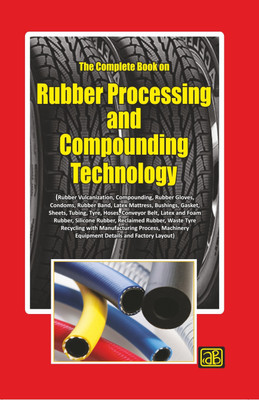The Complete Book on Rubber Processing and Compounding Technology (with Machinery Details) 3nd Revised Edition(English, Paperback, NIIR Board of Consultants, Engineers)
Quick Overview
Product Price Comparison
Rubber processing and compounding refer to the process of transforming natural or synthetic rubber into various usable products, such as tyres, rubber seals, belts, and hoses. The rubber processing industry encompasses various methods of transforming raw rubber into useful products, which include blending, mixing, extrusion, molding, and curing.Rubber compounding involves the addition of various additives, such as carbon black, antioxidants, curing agents, plasticizers, and other chemicals, to modify the physical and mechanical properties of the rubber. Compounding ingredients and techniques vary according to the end-use application and the desired properties of the final product. Rubber compounds are widely used in various industries, including automotive, construction, electrical, and healthcare. The unique properties of rubber compounds, such as durability, flexibility, and resistance to heat and chemicals, make them ideal for various applications.The market for rubber processing and compounding is positive, with increasing demand for high-performance and environmentally sustainable rubber products. Key trends driving this growth include a growing demand for electric vehicles, advancements in tyre technology, and increased demand for rubber products in emerging markets.The market is expected to grow at a steady rate in the coming years, with a compound annual growth rate (CAGR) of 5.3%. This growth can be attributed to the rising demand for high-performance and eco-friendly rubber products. The increasing demand for rubber processing and compounding services in the Asia-Pacific region is one of the primary drivers of the market growth. China and India are the key markets in the region, with high growth potential due to the growing automotive industry and government initiatives promoting the use of eco-friendly materials. Moreover, the increasing demand for tyres, rubber seals, gaskets, and hoses, coupled with advancements in the manufacturing process, is driving the growth of the market. Another trend driving the market is the growing focus on sustainability and reducing the carbon footprint. Many companies are investing in research and development to develop sustainable rubber products. The rubber processing and compounding industry is witnessing rapid growth in recent years. With the increasing demand for rubber products across various industries such as automotive, construction, healthcare, and electronics, the market outlook for this industry looks promising.The book's main contents are Mixing Technology of Rubber, Techniques of Vulcanization, Rubber Vulcanization, Rubber Compounding, Rubber Gloves Manufacturing, Condoms Manufacturing, Rubber Band Manufacturing, Latex Mattress Manufacturing, Rubber Bushings Production, Rubber Gasket Manufacturing, Rubber Sheets Manufacturing, Rubber Tubing and Its Manufacturing, Tyre Manufacturing, Waste Tyre Recycling Process, Hoses Manufacturing, Conveyor Belt Production, Latex and Foam Rubber, Silicone Rubber, Reclaimed Rubber, Rubber Natural. The Manufacturing Process, Machinery Equipment Details, and Photographs with Suppliers Contact Details are also given.A total guide to manufacturing and entrepreneurial success in todayŌĆÖs most demandable rubber processing and compounding industry. This book is one-stop guide to one of the fastest growing sectors of the rubber processing and compounding industry, where opportunities abound for manufacturers, retailers, and entrepreneurs. This is the only complete handbook on the commercial production of rubber. It serves up a feast of how-to information, from concept to purchasing equipment.


